Ways and Means

There is still plenty of time to raise hardier annuals from seeds sown now and these include cosmos, zinnias and marigolds. However it's often easier to opt for ready-grown plugs of these, as well as the more-tender begonias, petunias, antirrhinums and nicotiana. Large plugs come ready to pot up and the ideal compost for young plants like these is the loam-based John Innes 1. This will deliver enough food for the first stages of growth, but after that you will need to feed once a week with a weak potash-based tomato feed such as Tomorite. Increase the size of the pots if the roots become visible through the holes in the bottom. You can gently upend the plants to check.
When putting into position, always opt for larger containers because these need less water and look more visually pleasing. Avoid peat-rich multi-purpose compost and opt for loam-based John Innes 3 instead. The loam base holds water and nutrients far more effectively than lighter composts and is more forgiving when it comes to watering. Don't expose your summer bedding to the great outdoors until late-May or early June because cold nights will check their growth and a sharp frost may kill them. If you don't have a greenhouse, growhouse or cold frame, place your full pots in the most-sheltered position and cover them with a double layer of horticultural fleece on cool nights.
Pelargoniums
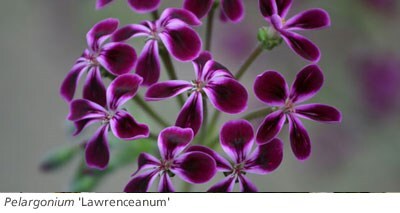
These South African plants, often called geraniums, will provide colour for many months with little or no maintenance. Just feed them and deadhead them and they will shine throughout summer and autumn. You can mass them together in a trough, or grow them in pots as elegant single specimens, or bed them into the ground. The choice is yours.
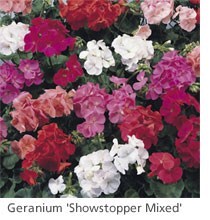 Pelargoniums offer variety as well as versatility. More modern, highly-bred pelargoniums come in showy colours and they produce rounded mops of large flowers above rounded scallops of leaf. You can either go for a riot of colour with Showstopper Mixed (in shades of pink, red, apricot, lilac and white), or opt for a fiery blend of coral, orange-red and cherry-red with Hot 'n' Spicy Mixed. Each plug will measure 5 - 7cm tall (over 2 inches in height) and will grow away quickly in a greenhouse, growhouse or on a windowsill once potted up. Pelargoniums offer variety as well as versatility. More modern, highly-bred pelargoniums come in showy colours and they produce rounded mops of large flowers above rounded scallops of leaf. You can either go for a riot of colour with Showstopper Mixed (in shades of pink, red, apricot, lilac and white), or opt for a fiery blend of coral, orange-red and cherry-red with Hot 'n' Spicy Mixed. Each plug will measure 5 - 7cm tall (over 2 inches in height) and will grow away quickly in a greenhouse, growhouse or on a windowsill once potted up.
Fragrance Galore
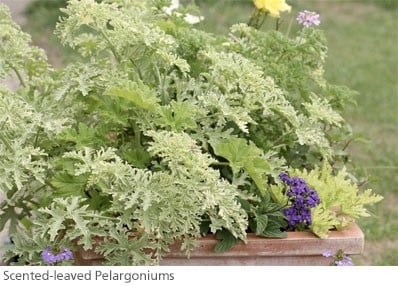
You might prefer something subtler and scented-leaved pelargoniums offer smaller, bee-friendly flowers and interesting foliage that scents the air whenever warm sun shines. The oily covering promoting the scent, is a natural sunscreen and it can provide mint, citrus or rose scent among others. You can't resist stroking the foliage of these plants so they make good arrangements near seats and doorways, or as single specimens along a low wall.
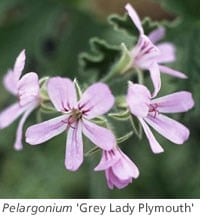 'Attar of Roses' really does smell of roses and the soft, vivid green foliage frames clusters of wispy pink flowers decorated with maroon-purple stamens and dark veining. Mingle this among the highly divided, grey-green and cream foliage of 'Grey Lady Plymouth', a minty pelargonium that is so much better than 'Lady Plymouth'. Then add one lemon verbena (Aloysia citrodora) to the arrangement for the narrow foliage born on wiry stems is pure lemon sherbert when stroked. This arrangement will please the eye and soothe the senses from June until late-October, for pelargoniums are capable of shrugging off late (but not too heavy) frosts. 'Attar of Roses' really does smell of roses and the soft, vivid green foliage frames clusters of wispy pink flowers decorated with maroon-purple stamens and dark veining. Mingle this among the highly divided, grey-green and cream foliage of 'Grey Lady Plymouth', a minty pelargonium that is so much better than 'Lady Plymouth'. Then add one lemon verbena (Aloysia citrodora) to the arrangement for the narrow foliage born on wiry stems is pure lemon sherbert when stroked. This arrangement will please the eye and soothe the senses from June until late-October, for pelargoniums are capable of shrugging off late (but not too heavy) frosts.

Invest in the scented pelargonium collection featuring five plants, 'Grey Lady Plymouth', the white-flowered 'Fragrans', the citrus scented 'Lemon Fancy', the pink-flowered 'Orsett' and the camphor-scented P. tomentosum - the pelargonium with the most strokeable foliage of all. Plant the latter on the edge so that it can ramble over the side, rather than smothering the others. There's also a fabulous white collection of pelargoniums containing five excellent varieties, all with a hint of pink to soften the effect.
If you want sophisticated elegance go for P. 'Ardens', a delicate pelargonium with long stems topped by smouldering red flowers, each petal touched in black. Or opt for the night-scented purple vision 'Lawrenceanum'. Or use the two-toned pale and lipstick-pink 'Renate Parsley' for its lax habit and masses of pansy-like flowers. These are equally good grown indoors.
More Colour

If you're looking for vivid colour the petunia has much to offer and the double-headed petunias have long-lasting flowers that shrivel up and get hidden by the others, a process called self-cleaning. Many are scented too, particularly in the evening, and the colors are excellent. Their lax habit looks good in a pot, or in a window box, or against a wall. The Pirouette Series comes in 'Double Pirouette F1 Mixed' and this will include pinks, whites and purples, or there's 'Double Pirhouette F1 Rose', which has white edges surrounding deep rose-pink ragged-middled flowers. Petunia breeding has improved their rain resistance and doubles endure - whatever the weather throws at them.
Extending the Season
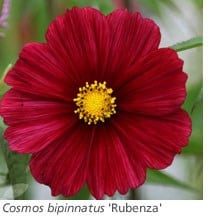 Most summer borders look great in the first half of summer, but they can look dull after the first flushes of roses and summer herbaceous have faded. These areas need late-flowering annuals and perennials and the airy South African annual cosmos will provide a series of large, bee-friendly daisies in pinks or whites above feathery foliage. 'Cosmos Sonata Hot Pink Mixed' could be grown on, then woven through a border and it's shorter than most (60cm), so an ideal addition for a smaller garden. 'Rubenza' is a taller (90cm) deep rose-pink, with neatly formed flowers, that eventually deepen to rose-red. Or go for the classic white single-flowered 'Purity' (1.2 m) - it's so aptly named. The scrolled petals of 'Sensation Picotee' (1.2m) are very pretty, and the pink-edged flowers come in various shades of pink. Most summer borders look great in the first half of summer, but they can look dull after the first flushes of roses and summer herbaceous have faded. These areas need late-flowering annuals and perennials and the airy South African annual cosmos will provide a series of large, bee-friendly daisies in pinks or whites above feathery foliage. 'Cosmos Sonata Hot Pink Mixed' could be grown on, then woven through a border and it's shorter than most (60cm), so an ideal addition for a smaller garden. 'Rubenza' is a taller (90cm) deep rose-pink, with neatly formed flowers, that eventually deepen to rose-red. Or go for the classic white single-flowered 'Purity' (1.2 m) - it's so aptly named. The scrolled petals of 'Sensation Picotee' (1.2m) are very pretty, and the pink-edged flowers come in various shades of pink.
If you've lots of roses add some Cleome, a spiny tall annual with spidery flowers that come in rose shades and white. Cleome hassleriana 'Violet Queen' can be raised from seed but 'Odyssee Mixed', a mixture of purples, whites and pinks, is available in plug form. These South American annuals need a warm situation to do well though. If happy they will bush out and reach 1.2m.
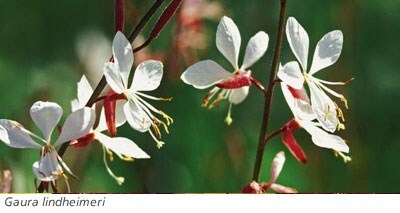
Finally think about adding Gaura lindheimeri, sometimes known as whirling butterflies, for its willowy white or pink flowers will still be adding sparkle in November. 'Rosyjane' has white petals with a pink picotee edge. 'Whirling Butterflies' is a traditional white and 'Siskiyou Pink' a taller deep-pink. These will form long-legged wands in the garden and their flowers somehow suit the decadent, relaxed air of autumn. Good sun and good drainage are vital to gaura if they are to overwinter successfully.
Hoverfly Magnets for Pest Control 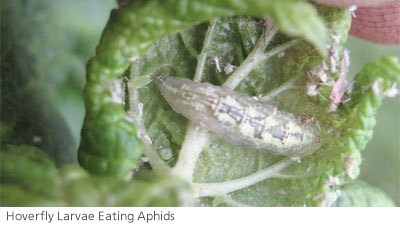
Certain annuals are highly attractive to small flies and hoverflies. Some of these are valuable predators in the garden, particularly some hoverfly larvae. These rather maggot-like creatures emerge for a rugby-ball shaped egg and devour aphids, before pupating and then emerging as a hoverfly. They have much smaller mouthparts than most pollinators so they prefer tiny flowers, such as umbellifers. Ammi majus, a white dome of lace flowers, is one of their favourites and it's possible to buy plugs now. These will flower by late-summer. Ammi makes a good cut flower to go with sweet peas in a vase. They also set off more colourful flowers in a cut flower border that might contain other annuals including clary, blue cornflower, calendula and annual poppies.

Hoverflies home in on orange and bright-yellow so marigolds make excellent edging used with mixed lettuces and colourful nasturtiums. Marigold 'French Fancy', a mixture of hot colours, will provide acid-yellows, rich golds, orange and shades of mahogany and red and the flowers are open-centred enough to sustain pollinators.
 Tropaeolum majus 'Black Velvet' (Tom Thumb Series) is a nasturtium that will not ramble too far, just trail gently, and it keeps its black flowers well above the neat, green foliage. It's also an edible flower that looks stunning in salads mixed with blue borage flowers. There's plenty of time to sow some large nasturtium seeds in modular trays, one per compartment. Or they can go directly into the ground, but these frost-prone plants must not go into the garden until early June. You can also sow borage now - it's an essential Pimms ingredient. Tropaeolum majus 'Black Velvet' (Tom Thumb Series) is a nasturtium that will not ramble too far, just trail gently, and it keeps its black flowers well above the neat, green foliage. It's also an edible flower that looks stunning in salads mixed with blue borage flowers. There's plenty of time to sow some large nasturtium seeds in modular trays, one per compartment. Or they can go directly into the ground, but these frost-prone plants must not go into the garden until early June. You can also sow borage now - it's an essential Pimms ingredient.
|
|
Things to do
 |
Prune Late-flowering Clematis

Clematis pruning can be baffling. Any clematis that flowers before Midsummer's Day (June 21st) is never pruned hard. This includes winter-flowering clematis and spring-flowering 'alpinas' and macropetalas. Leave these alone and tidy them very slightly after flowering - but only if they need it. If you grow small-flowered clematis that flower after Midsummer's Day, many will probably have Clematis viticella in their ancestry. These are best cut back to the lowest buds now, to encourage vigorous new growth. All clematis come with pruning instructions on their labels. Remove them and keep them somewhere safe so you can refer to them if you need to.
|
 |
Sow Cabbage Seed
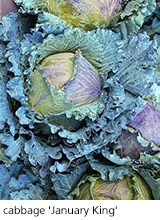 If you're a vegetable grower sow your cabbages now. These mainstays are easy to grow as long as they do not stall in their early stages. Sow one seed in each compartment in modular seed trays and transplant once the young plants are three inches in height. Net straight away. Good varieties include Kale 'Nero di Toscana', Cabbage 'Hispi' and 'Broccoli Purple Sprouting Late'.
|
 |
Get Planting
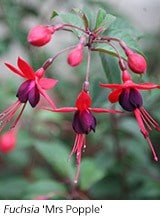
Late-April is a good time to plant slightly tender late summer plants, such as the hardy fuchsia 'Mrs Popple'. Planted now this will have several months to put out roots. However, planted in September, it's likely to succumb to winter weather due to lack of root. Perovskias and tender salvias like 'Wendy's Wish' can all be planted now in warm, sunny positions. If a late frost is forecast place a bucket over your plant.
|
 |
Sow Cucurbit Seeds
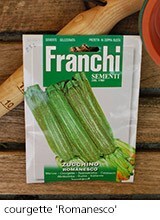
The middle of April is an excellent time to sow cucurbits so that they are ready to go outside in early June. Courgette seeds, cucumbers and winter squashes all benefit from cloches once planted out, because warm nighttime temperatures encourage growth. The lidded kitchen garden cloches would be ideal and will last for many a year.
|
 |
Create a Herb Garden
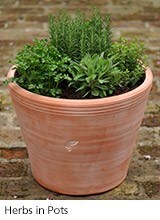
Fill a container with herbs to create a small herb garden using the herb collection. Be imaginative, you could use a galvanised container, or an old basket. Then on damp days you can gather herbs without getting muddy. |
|
|
Essential Kit for April

Terracotta arc pot
from £49.99

Flared rim terracotta pot
from £24.99
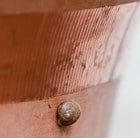
Copper flexi snail tape
was £7.99 now £6.99
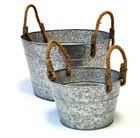
Galvanised planters with rope handles
from £7.99
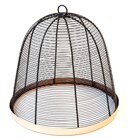
Copper rimmed cloche
was £34.99 now £29.99

Wide hanging basket
from £24.99
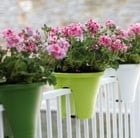
Round railing pots
was £7.99 now £6.99
|
|



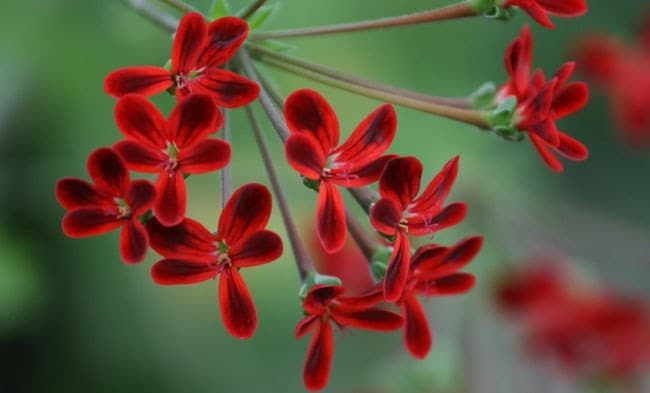











 Tropaeolum majus 'Black Velvet'
Tropaeolum majus 'Black Velvet'











